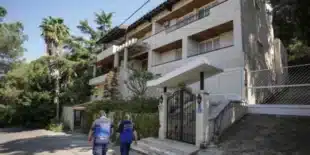Just before a Hamas-initiated conflict erupted from Gaza, one of the Palestinian territories’ most prominent sports complexes received a significant upgrade. This refurbishment, costing $519,000 and funded by U.S. taxpayers, included new basketball, volleyball, and tennis courts, a soccer field, a running track, and accessible bathrooms.
However, recent developments have severely damaged this facility. Satellite images reveal that the Gaza Sports Club’s roof is extensively damaged, and its AstroTurf field is crushed under heavy tanks. These observations were made by The Associated Press through satellite imagery.
Since October, at least five community and youth projects in Gaza, backed by U.S. funding, have suffered damage or destruction, presumably by the U.S.-supported Israeli military. Despite this, most major U.S.-funded infrastructure projects in Gaza have remained largely untouched, a result of the U.S. government sharing their locations with the Israeli military for many years.
The Israeli offensive is a response to a Hamas attack in Israel on Oct. 7, which resulted in approximately 1,200 deaths and numerous hostages. In Gaza, controlled by Hamas, health officials report over 20,000 Palestinian fatalities and nearly 1.9 million displaced individuals.
The United Nations reports more than 37,000 structures in Gaza have been either destroyed or damaged in the conflict.
Since establishing a U.S. Agency for International Development mission in the West Bank and Gaza, the U.S. has invested over $7 billion in aid, including $270 million under President Joe Biden’s administration. Additionally, the U.S. annually provides Israel with over $3 billion in military support, with a commitment to increase this to over $14 billion in 2023.
Howard Sumka, a former USAID mission director, reflected on the cyclical nature of providing aid and then witnessing its destruction, likening it to the myth of Sisyphus.
A review of U.S. contracts and grants in Gaza identified over 30 American-funded construction projects. Maxar Technologies’ satellite imagery analysis, corroborated by separate satellite images from Planet Labs, indicates that while many major U.S.-backed projects are intact, at least five have sustained damage.
The Israeli military has not commented on these damages to U.S.-supported structures.
While the exact cause of the damage in the images is indeterminate, some cases have been linked to Israeli military actions near U.S.-backed projects through news reports and government sources.
Israel attributes this damage to Hamas, accusing them of using civilian infrastructure for military purposes, including hiding fighters and weapons. Additionally, Israel claims that many Hamas rockets intended for Israel have landed within Gaza.
The AP’s efforts to reach Palestinian officials in Gaza were hindered by communication disruptions.
The CEO of Anera, a U.S. contractor involved in projects like the Sports Club, lamented the destruction as a “terrible tragedy,” emphasizing the long-term impact on infrastructure and human lives.
For instance, the Arab Orthodox Cultural Center, built with $138,000 of U.S. aid, now shows significant damage in recent satellite images. Similarly, two centers for children with disabilities, funded with U.S. aid, appear to have been damaged or destroyed.
In contrast, the Gaza YMCA library, renovated with U.S. funds, remains intact, despite neighboring destruction.
The Rosary Sisters School, which received a $495,000 upgrade from U.S. funds, suffered some damage in recent airstrikes, as seen in Maxar images.
Significant U.S.-funded projects in Gaza, essential for the region’s infrastructure, remain largely intact. This includes a $16 million desalination plant and other water facilities costing around $7 million.
Former USAID directors attribute this to thorough communication between U.S. officials and the Israeli military. Dave Harden, a former mission director, described his direct involvement in providing project coordinates to Israeli officials.
The USAID mission in Gaza has historically focused on smaller projects, gradually expanding to larger infrastructure developments. Christopher Crowley, the first USAID mission director in the region, initiated projects like children’s playgrounds, which evolved into larger undertakings like road refurbishments and apartment construction.
These projects were often agreed upon by both Palestinian and Israeli governments, with the U.S. acting as a mediator. The goal was to lay the groundwork for a future Palestinian state alongside Israel.
However, the ongoing conflict has posed significant challenges to these efforts. For example, a major U.S. water project was put on hold when Hamas, designated as a terrorist organization by the U.S., took control of Gaza in 2007. Since then, USAID has been limited in its operations in the area.
The recent war’s scale may further influence USAID’s future capabilities in Gaza. Rebuilding efforts are contingent on Israel’s approval, which may be hesitant without assurances that materials won’t be used for weaponry by Hamas.
Former USAID directors express diminishing hope for Gaza’s future, citing the challenges in negotiating a solution and the repetitive cycle of rebuilding and destruction. Despite this, they recognize the importance of continuing humanitarian aid and development assistance as a means of stabilizing the region and providing hope to its people.


